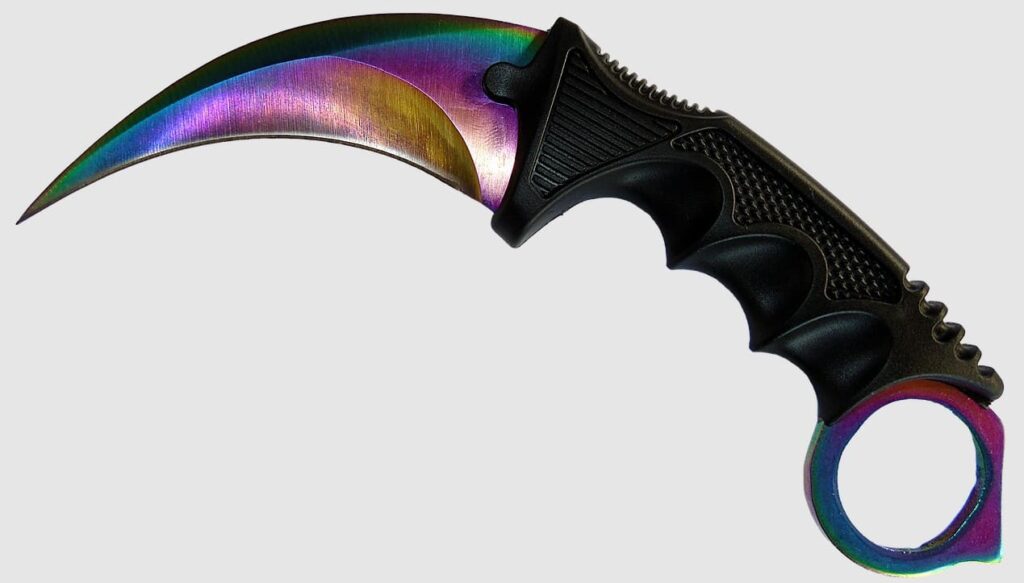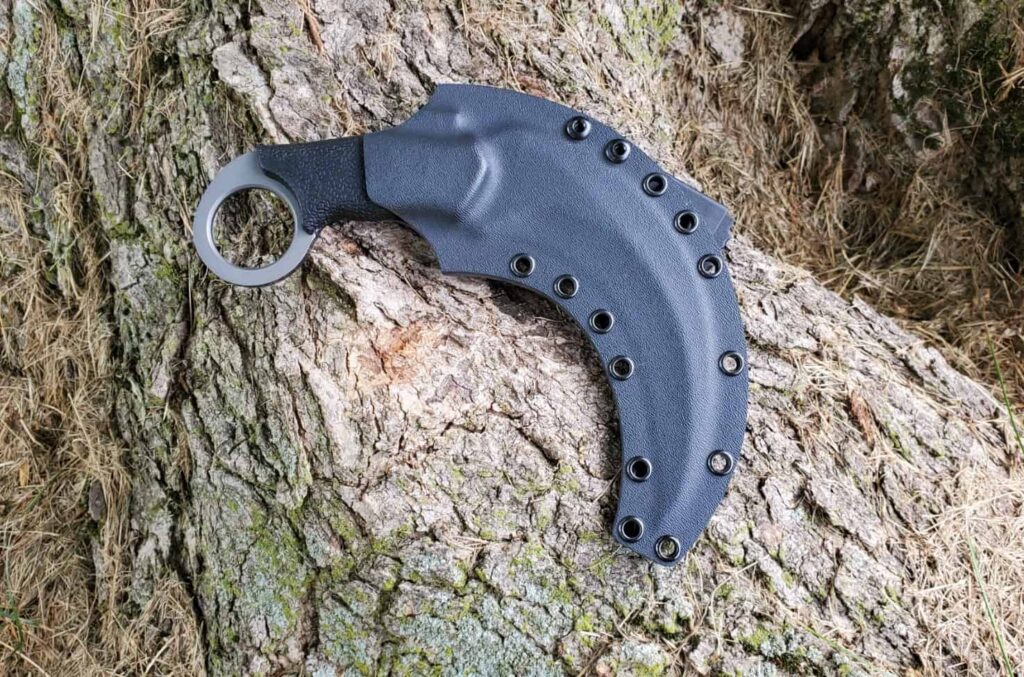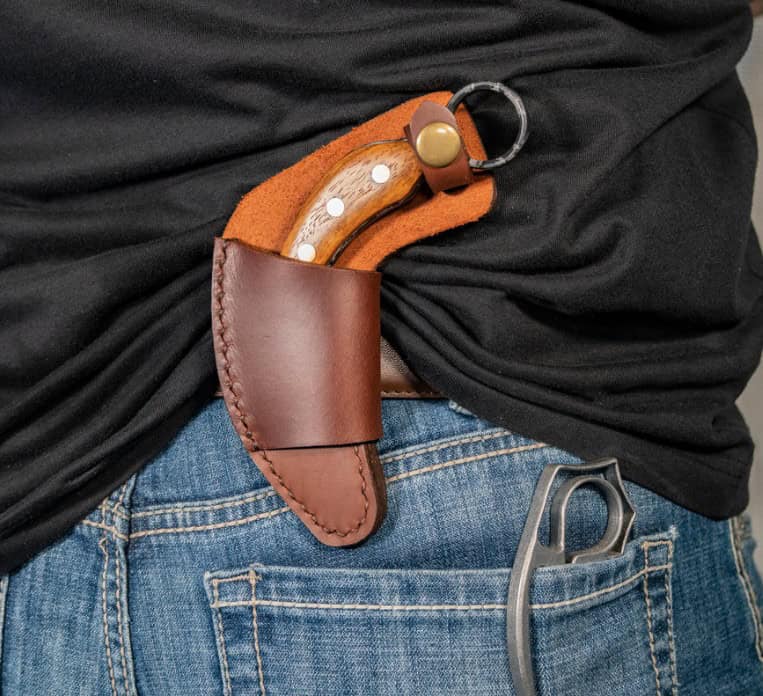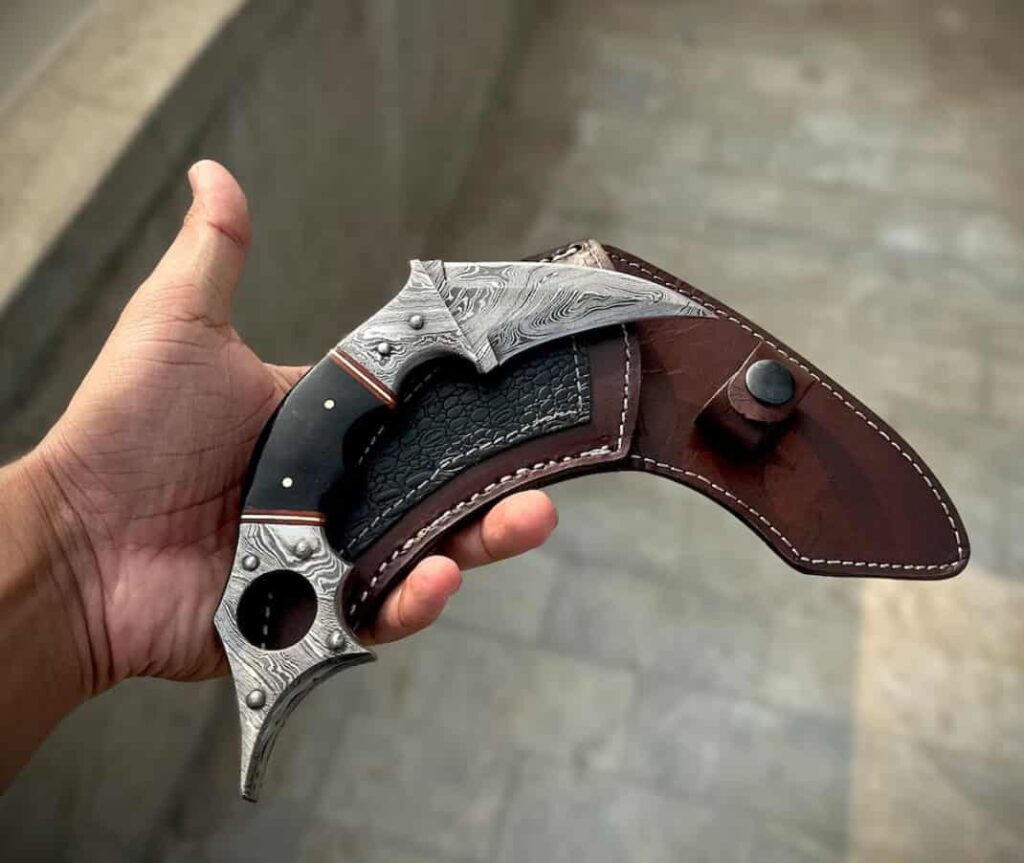What is a Karambit Holster?
TLDR: A karambit holster is a specialized sheath designed to securely hold a karambit knife, allowing for safe carrying, drawing, and reholstering.
As a karambit enthusiast, I can’t help but get excited when talking about these unique curved blades and the gear that goes with them. Karambit holsters are an essential accessory for anyone who carries this fascinating knife, whether for self-defense, martial arts training, or everyday utility. I’ve always been amazed by how the right holster can transform the way you carry and use a karambit. It’s not just about having a place to stash your blade – a good holster enhances safety, accessibility, and comfort. In my experience, finding the perfect karambit holster is like discovering a hidden gem. It’s a game-changer that lets you fully appreciate the knife’s distinctive design and versatility. From sleek leather sheaths to high-tech Kydex rigs, there’s a whole world of holster options out there, each with its own pros and cons.
Understanding the Karambit
The karambit’s design is a work of art, if you ask me. It’s got this wicked curved blade that reminds me of a tiger’s claw – talk about intimidating! But what really sets it apart is the safety ring at the end of the handle. I reckon it’s one of the most genius features in knife design. It gives you a rock-solid grip and lets you pull off some pretty slick moves.
Here’s a quick rundown of the key design features:
- Curved blade (usually 2-4 inches long)
- Ergonomic handle
- Safety ring
- Sometimes a serrated edge
- Can be fixed blade or folding
Now, here’s where it gets really interesting. The karambit’s got roots deep in Southeast Asian history, dating back to the 11th century in Indonesia. It blows my mind to think that farmers were using these bad boys for everyday tasks like harvesting crops and threshing rice. Talk about versatile!
As trade routes expanded, the karambit spread its influence across Southeast Asia. I’d bet those ancient traders had no idea how far their humble farm tool would go. From agriculture to warfare, the karambit adapted and evolved, becoming a staple in many cultures.
These days, the karambit’s found its true calling in martial arts and self-defense. It’s a favorite in Filipino martial arts like Eskrima and Kali, and I can see why. The curved blade and safety ring make it perfect for those fluid, circular movements that look so darn cool.

But it’s not just about looking flashy. The karambit’s design gives it some serious advantages in self-defense situations:
| Advantage | Description |
| Retention | The safety ring makes it nearly impossible to disarm |
| Versatility | Can be used for slashing, hooking, and even punching |
| Concealability | Compact size makes it easy to carry discreetly |
I’ve got to say, though, wielding a karambit effectively takes some serious skill. It’s not your average straight blade, and the techniques are pretty unique. But man, when you see someone who really knows how to use one, it’s like watching a deadly dance.
Types of Karambit Holsters
Man, the world of karambit holsters is like a candy store for knife enthusiasts – so many options, each with its own flavor! I’ve tried my fair share, and let me tell you, finding the right holster can totally change your karambit game. Fixed holsters are the bread and butter of karambit carry, if you ask me. They’re straightforward and reliable – just what you need for everyday use.
Belt holsters are my go-to for daily carry. They clip right onto your belt, keeping your karambit within easy reach. I reckon they’re perfect for those who want quick access without any fuss. Plus, they look pretty sleek if you ask me. Now, sheath holsters are like the classic cars of the karambit world – timeless and dependable. They’re fantastic for fixed-blade karambits, offering solid protection and a snug fit. I’ve got a leather sheath that’s molded perfectly to my favorite karambit over time – it’s like they were made for each other.
When you’re feeling a bit more adventurous, tactical holsters are where it’s at. They’re like the Swiss Army knives of the holster world – versatile and ready for action. Drop leg holsters make me feel like I’m in an action movie every time I strap one on. They’re great for outdoor activities or when you need to keep your waist clear. I love using mine when I’m hiking or camping – it keeps my karambit accessible without getting in the way of my backpack straps. Shoulder holsters might seem a bit James Bond, but don’t knock ’em till you’ve tried ’em. They distribute weight well and can be surprisingly comfortable. I’ve found they’re perfect for concealed carry under a jacket, especially in cooler weather.
Sometimes you need to keep things on the down-low, and that’s where concealed carry holsters shine. IWB holsters are like ninjas – stealthy and effective. They tuck your karambit away discreetly, and no one’s the wiser. I’ve found them to be incredibly versatile for different clothing styles. My IWB holster is my go-to for everyday concealed carry. Ankle holsters are the dark horses of the karambit world. They’re not for everyone, but I think they’re brilliant for certain situations. They’re perfect when you need deep concealment or as a backup option. I keep one as part of my EDC rotation, especially when I’m wearing looser pants.
Here’s a quick comparison of the different types based on my experience:
| Holster Type | Concealment | Accessibility | Comfort | Best For |
| Belt | ⭐⭐⭐ | ⭐⭐⭐⭐⭐ | ⭐⭐⭐⭐ | Everyday carry |
| Sheath | ⭐⭐ | ⭐⭐⭐⭐ | ⭐⭐⭐ | Fixed-blade karambits |
| Drop Leg | ⭐⭐ | ⭐⭐⭐⭐⭐ | ⭐⭐⭐ | Outdoor activities |
| Shoulder | ⭐⭐⭐⭐ | ⭐⭐⭐ | ⭐⭐⭐⭐ | Concealed carry under jackets |
| IWB | ⭐⭐⭐⭐⭐ | ⭐⭐⭐ | ⭐⭐⭐ | Discreet everyday carry |
| Ankle | ⭐⭐⭐⭐⭐ | ⭐⭐ | ⭐⭐ | Deep concealment or backup |
In my book, there’s no one-size-fits-all when it comes to karambit holsters. It’s all about finding what works best for your lifestyle and preferences.
Materials Used in Karambit Holsters
You know, the material of a karambit holster can make or break your entire carry experience. I’ve tried just about every type out there, and let me tell you, each one has its own personality.
Leather holsters are like that classic rock album you never get tired of. They just get better with age, molding to your karambit like a second skin. I’ve got this leather sheath I’ve been using for years, and it’s developed this gorgeous patina that tells a story all its own. Sure, they might need a bit more TLC, but in my book, that’s part of the charm.
Now, Kydex is the new kid on the block that’s been turning heads. It’s like the smartphone of holster materials – sleek, modern, and oh-so-functional. The first time I heard that satisfying ‘click’ when holstering my karambit in a Kydex sheath, I was sold. It’s tough as nails and holds its shape like a champ. Some folks say it’s not as comfortable as leather, but I reckon it’s all about finding the right fit.
Nylon holsters are the unsung heroes of the karambit world. They’re like that reliable friend who’s always there when you need them. Lightweight, affordable, and easy to maintain – what’s not to love? I’ve got a nylon drop leg holster that’s been through hell and back on camping trips, and it’s still going strong.
But here’s where it gets really interesting – hybrid materials. It’s like someone took the best parts of each material and mashed them together. I’ve got this leather and Kydex combo holster that gives me the classic look of leather with the retention of Kydex. It’s the best of both worlds, if you ask me.
Here’s a quick rundown of how I rate each material:
| Material | Durability | Retention | Comfort | Maintenance | Style |
| Leather | ⭐⭐⭐⭐ | ⭐⭐⭐ | ⭐⭐⭐⭐⭐ | ⭐⭐ | ⭐⭐⭐⭐⭐ |
| Kydex | ⭐⭐⭐⭐⭐ | ⭐⭐⭐⭐⭐ | ⭐⭐⭐ | ⭐⭐⭐⭐⭐ | ⭐⭐⭐⭐ |
| Nylon | ⭐⭐⭐ | ⭐⭐ | ⭐⭐⭐⭐ | ⭐⭐⭐⭐ | ⭐⭐⭐ |
| Hybrid | ⭐⭐⭐⭐ | ⭐⭐⭐⭐ | ⭐⭐⭐⭐ | ⭐⭐⭐ | ⭐⭐⭐⭐ |
At the end of the day, choosing a holster material is like picking your favorite ice cream flavor – it’s all about personal preference. I’ve found that having a variety of holsters made from different materials gives me the flexibility to adapt to any situation. Whether I’m dressing up for a night out or gearing up for a wilderness adventure, there’s a karambit holster material that fits the bill.
Considerations When Choosing a Karambit Holster
Picking the perfect karambit holster is like finding the right dance partner – it’s gotta match your style, move with you, and keep you feeling secure. I’ve been through my fair share of holsters, and let me tell you, there’s a lot to think about when making your choice.
First off, comfort and fit are non-negotiable in my book. I once had this holster that chafed like sandpaper on sunburn – never again! Now, I always make sure to test drive a holster before committing. Does it sit right? Can I move freely? A good holster should feel like it’s part of you, not some clunky add-on. I’ve found that adjustable holsters are a game-changer for getting that perfect fit.

Now, let’s talk about accessibility and draw speed. What’s the point of carrying a karambit if you can’t get to it when you need it? I had this one holster that was like trying to solve a Rubik’s cube blindfolded – not ideal in a pinch. These days, I practice my draw religiously with any new holster. Can I get to my karambit smoothly and quickly? If not, it’s back to the drawing board. I’ve found that the placement of the holster can make a huge difference in draw speed.
Retention and security are where the rubber meets the road. A holster that can’t keep your karambit in place is about as useful as a screen door on a submarine. I’m a big fan of holsters with adjustable retention. It lets you find that sweet spot between “secure enough to do cartwheels” and “I can actually get my knife out when I need it.” I once lost a karambit during a hiking trip because of poor retention – never making that mistake again!
Lastly, you’ve gotta consider your intended use. Are you carrying for everyday use, training, or something more specialized? I’ve got different holsters for different scenarios. My everyday carry holster is all about discretion and comfort, while my training holster prioritizes quick draws and durability. For outdoor activities, I lean towards holsters with extra retention and weather resistance.
Here’s a quick rundown of what I look for in different scenarios:
| Scenario | Top Priorities | Features I Look For |
| Everyday Carry | Comfort, Concealment | Slim profile, Adjustable retention |
| Training | Durability, Quick Draw | Reinforced edges, Open-top design |
| Outdoor Activities | Weather Resistance, Security | Water-resistant materials, Extra retention straps |
| Formal Events | Deep Concealment | Ultra-thin design, Minimal printing |
At the end of the day, choosing a karambit holster is a personal journey. What works for me might not work for you, and that’s the beauty of it. It’s all about experimenting and finding what feels right. I’ve had some hits and misses along the way, but each holster taught me something new about my preferences and needs.
How to Properly Use a Karambit Holster
You know, mastering the art of using a karambit holster is like learning a secret handshake – it takes practice, but once you’ve got it down, you feel like part of an exclusive club. I’ve spent countless hours perfecting my technique, and I’m still learning new tricks.
When it comes to safe drawing techniques, it’s all about smooth, deliberate motions. I always start by getting a solid grip on the handle before even thinking about pulling it out. With that safety ring, you’ve got to be mindful of your finger placement. I’ve found that a consistent draw stroke is key – it’s not about speed at first, it’s about building muscle memory. Once you’ve got the movement down pat, then you can work on picking up the pace. I like to practice my draw in front of a mirror, making sure my form is on point.
Reholstering is where a lot of folks slip up, but it’s just as important as the draw. I always take a moment to visually check my holster before sliding the karambit back in. It’s tempting to try and look cool with a quick reholster, but that’s a one-way ticket to Slice City, population: your hand. My mantra is “slow is smooth, smooth is safe.” I make sure the path is clear, then guide the karambit in with intention. If there’s any resistance, I stop and reassess – forcing it is never a good idea.
Now, let’s talk about maintenance and care for your holster. This is where the magic happens, folks. A well-maintained holster not only lasts longer but also performs better. It’s like giving your karambit a happy home – treat it right, and it’ll always be there for you when you need it. I’ve got a whole ritual for keeping my holsters in tip-top shape. For leather, I use a good conditioner to keep it supple. Kydex gets a wipe-down to keep it clean and functioning smoothly. And don’t get me started on the importance of checking your retention screws – a loose screw can turn your secure holster into a karambit launching pad real quick.
Here’s my personal holster maintenance schedule:
| Holster Type | Daily | Weekly | Monthly |
| Leather | Wipe down with soft cloth | Apply leather conditioner | Deep clean, check stitching |
| Kydex | Check retention | Wipe with damp cloth | Adjust screws, check for cracks |
| Nylon | Brush off debris | Spot clean as needed | Wash with mild soap if necessary |
| Hybrid | Wipe down | Condition leather parts | Check all components, clean thoroughly |
I’ve found that sticking to a maintenance routine not only keeps your holster in great shape but also gives you a chance to inspect it regularly for any wear and tear. It’s like bonding time with your gear – you get to know every nook and cranny.
Where Can I Get a Karambit Holster?
If you’re looking to get a karambit holster, you can find them at specialty knife shops, outdoor gear retailers, and online stores. Be sure to choose one that fits your karambit properly and suits your preferred carry style, whether it’s leather, Kydex, or another material.
Karambit

Bone Tactical

RavenCraftES

AlbertaTikiShack

Final Thoughts
Taking care of my karambit holster and mastering the draw and reholstering techniques is something I’ve come to appreciate more and more. It’s not just about the thrill of using such a unique tool, but about the discipline and respect that comes with it. I’ve learned that a smooth, consistent draw is far more valuable than trying to go fast right out of the gate. Honestly, there’s something satisfying about the ritual of holster maintenance too—whether it’s conditioning leather or tightening up a Kydex holster, each step feels like I’m building a deeper connection with my gear. I do think people sometimes overlook the importance of reholstering safely, but for me, it’s become second nature to take it slow and ensure everything’s in its place. Overall, this whole process has turned into a bit of a passion, combining the practical with the almost meditative aspect of caring for something you rely on. And when you think about it, the karambit definitely ranks among the most fascinating weapons out there, fitting right in with some of the coolest weapons in history.
